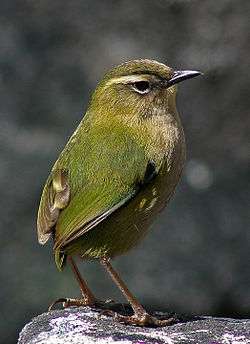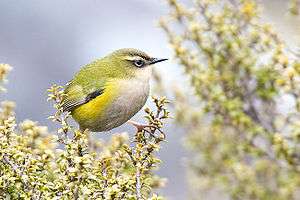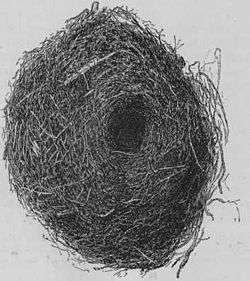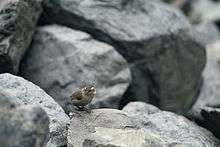New Zealand rock wren
| New Zealand rock wren | |
|---|---|
 | |
| Scientific classification | |
| Kingdom: | Animalia |
| Phylum: | Chordata |
| Class: | Aves |
| Order: | Passeriformes |
| Suborder: | Acanthisitti |
| Family: | Acanthisittidae |
| Genus: | Xenicus |
| Species: | X. gilviventris |
| Binomial name | |
| Xenicus gilviventris Pelzeln, 1867 | |
The New Zealand rock wren (Xenicus gilviventris) is a small New Zealand wren (family Acanthisittidae) endemic to the South Island of New Zealand. Its Māori names include pīwauwau ("little complaining bird"), mātuitui, and tuke ("twitch", after its bobbing motion).[2] Outside New Zealand it is sometimes known as the rockwren or South Island wren to distinguish it from the unrelated rock wren of North America.
The rock wren is currently restricted to alpine and subalpine areas of the South Island; subfossil bones show it once lived in the North Island as well. It is a poor flier and highly terrestrial, feeding in low scrub, open scree, and rockfalls. The rock wren and rifleman are the only two surviving New Zealand wrens; the rock wren's closest relative was the now-extinct bush wren. Its numbers are declining due to predation by introduced mammals.
Description

The rock wren is a very small, almost tailless bird that prefers to hop and run on its long legs, and uses its rounded wings to fly only short distances. Males are 16 g, females 20 g. Males are greenish with yellow flanks and a pale underside, females tend to be browner, although the degree of difference between the sexes varies geographically.[3]
Distribution and habitat
This species is currently confined to alpine and subalpine zones (900–2500 m altitude) of the Southern Alps, the Tasman Mountains of Northwest Nelson, and the Victoria Range of Westland, all in the South Island;[3] it is New Zealand's only truly alpine bird.[4] Subfossil remains suggest before Polynesian settlement it was also found in lowland forest and in the North Island. Its current alpine distribution is a habitat where few rodents can survive, full of sheltering rocks and dense vegetation.[5]

Their preferred habitat is close to the treeline, amongst rockfalls, scree, fellfield, and low scrub. Rock wrens, unlike many alpine birds, do not migrate to lower elevations in winter;[3] instead, they seem to shelter and forage in rockfalls beneath the snow layer.[2]
Behaviour
The rock wren is a poor flier, rarely flying more than 2 m off the ground or for distances of more than 30 m. It prefers to hop and run with distinctive bobbing and wing flicks.[6] Its call is three high-pitched notes, and pairs sometimes duet.[3]
Pairs maintain a year-round territory, and work together to build a large enclosed nest with an entrance tunnel. The nest is lined with feathers, often from other species of birds. Guthrie-Smith recovered 791 feathers from one nest in the 1930s, most from weka, but including some kiwi, kakapo, kea, and kereru.[7] (Rock wrens are such assiduous collectors of feathers that their nests have been checked for kakapo feathers, to determine if those endangered parrots are in the area.)[2] Around three eggs are laid in late spring and incubated for three weeks. Chicks take about 24 days to fledge and are fed for at least 4 weeks.[2][3]
Rock wrens mostly eat invertebrates on the ground, but will sometimes take berries and seeds, and even nectar from flax flowers.[3]
Conservation

Writing in the 1930s,[7] Herbert Guthrie-Smith declared,
| “ | Xenicus gilviventris, I am glad to think, is one of the species likely to survive changes that from the forester’s and field naturalist’s point of view have desolated New Zealand. The ravages wrought elsewhere by deer, rabbits, opossums, birds, and other imported vermin are unlikely to affect the welfare of the rock wren. Even weasels and rats — and I know they ascend to great heights — are hardly likely to draw sufficient recompense in prey from such unpeopled solitudes.… With cover and food supplies unmodified, the rock wren may be considered relatively safe. | ” |
This was not to be. Since European settlement, rock wrens have become more patchy in their distribution; a study of over 2,100 sightings between 1912 and 2005 showed the area they inhabit had declined significantly since the 1980s.[4][8] In the Murchison Mountains, rock wren showed a 44% decline in abundance over 20 years.[4] The main threats to rock wrens are stoats and mice, which eat their eggs and young: A 2012–13 study in the upper Hollyford showed that most rock wren nests were being preyed upon by stoats.[6] The long-term effect of climate change on their alpine habitat is also a threat, as warmer temperatures will allow rats to move higher into the mountains.[2]
In 2008–2010, a total of 40 rock wrens were translocated to Secretary Island, an 8140 ha rodent-free island in Fiordland, the third-tallest island in New Zealand.[2] In 2010 a survey located 12 unbanded rock wrens, indicating they were successfully breeding.[9]
References
- ↑ BirdLife International (2012). "Xenicus gilviventris". IUCN Red List of Threatened Species. Version 2013.2. International Union for Conservation of Nature. Retrieved 26 November 2013.
- 1 2 3 4 5 6 Warne, Kennedy (June 2009). "The Also Wren". New Zealand Geographic (97): 80–91.
- 1 2 3 4 5 6 Heather, Barrie D.; Robertson, Hugh A. (2005). The Field Guide to the Birds of New Zealand. Auckland: Penguin. p. 374. ISBN 978-0-14-302040-0.
- 1 2 3 Michelsen-Heath, Sue; Gaze, Peter (2007). "Changes in abundance and distribution of rock wren (Xenicus gilviventris) in the South Island, New Zealand". Notornis. 54 (2): 71–78.
- ↑ Worthy, Trevor N.; Holdaway, Richard N. (2002). The Lost World of the Moa. Bloomington, IN: Indiana University Press. p. 425. ISBN 0-253-34034-9.
- 1 2 Gaze, Peter D. (2013). Miskelly, Colin M., ed. "Rock Wren". New Zealand Birds Online. Retrieved 6 April 2016.
- 1 2 Guthrie-Smith, Herbert (1936). Sorrows and Joys of a New Zealand Naturalist. Dunedin: A. H. & A. W. Reed.
- ↑ "Rock wren sightings sought as figures fall". Otago Daily Times. 30 December 2008. Retrieved 30 December 2008.
- ↑ "New Zealand Rock wren thriving on new sanctuary". Wildlife Extra. Retrieved 6 April 2016.
Further reading
- BirdLife International (2006) Species factsheet: Xenicus gilviventris. Downloaded from http://www.birdlife.org on 12/2/2007
External links
| Wikispecies has information related to: Xenicus gilviventris |
| Wikimedia Commons has media related to Xenicus gilviventris. |
- New Zealand rock wren discussed on RadioNZ Critter of the Week, 22 Jan 2016
- Specimens in the collection of the Museum of New Zealand Te Papa Tongarewa including holotype and syntypes

